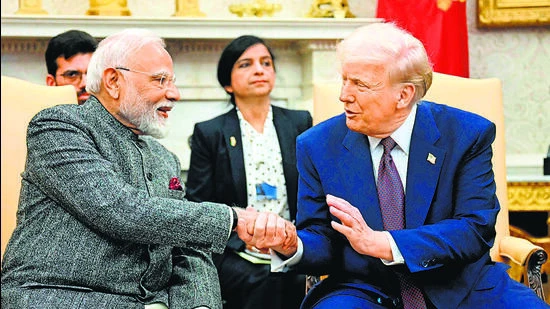The fine print of a preliminary trade deal between India and the US has mostly been worked out by negotiators from both sides but the ball is now in the court of the political leadership to break a stalemate, people aware of the parleys told HT, disclosing two of the topmost sticking points that remain.
According to these people, these issues are: an unequivocal assurance that New Delhi seeks from Washington that all punitive levies will be repealed, and a freer access to India’s politically sensitive agriculture sector that the American side has sought.
“The two-day deliberation that started in Washington on Thursday will likely stretch over to next week,” one of these people, who has direct knowledge of the talks, told HT.
Both sides are in a sprint to announce a breakthrough, which will be a preliminary deal covering some portion of the trade between two nations, with a larger bilateral trade deal expected to be signed by October.
Once the deal is done, India wants America to withdraw all existing and potential retaliatory tariffs, including the 26% reciprocal tariff – this comprises a 10% baseline tariff imposed from April 5 and an additional 16% country-specific levy set to trigger from July 9.
India also wants the US to revoke all safeguard duties disputed at the World Trade Organisation-50% on Indian steel and aluminium and 25% on automobiles and auto parts-and to reciprocate New Delhi’s move by proportionately slashing its most favoured nation tariffs.
“Washington has not yet given any unequivocal commitment on these matters, which are crucial for Indian interests,” another person said.
American negotiators have been suggesting India replicate the US-UK Economic Prosperity Deal model, where Britain accepted continued 10% baseline tariffs on most goods while securing relief from additional sectoral tariffs. However, Indian negotiators have rejected this approach.
The other sticking point is the US insistence on India opening its agriculture and farming sector. While the American side is open to tariff rate quotas (TRQ) – a mechanism under which concessional duty or duty-free access of any specified item applies to a limited quantity – their insistence on some sensitive sectors is a challenge.
“The problem lies in wanting India to also open its sensitive sectors. Dairy imports are restricted for two reasons. First, India’s dairy farming is at a subsistence level with one or two cows or buffaloes. The livelihoods of millions of farmers are at stake as they could not compete with America’s commercial-scale dairy farms. Secondly, the US cattle feed includes non-vegetarian products, something against religious sentiments of Indian consumers,” a third person said.
Similarly, India is unable to accept the US demand to allow unrestricted access to American agricultural items such as corn and soybean because Indian law does not permit genetically modified crops. “America is unwilling to accept an institutional mechanism which would certify that its India-bound agriculture produce are not genetically modified, saying there is a practical problem in segregating GM and non-GM products,” this person said.
This person added that solving such issues now require a political directive from the highest levels of the government. “While majority of issues have been resolved with near consensus, including on removing tariff and non-tariff barriers on most of the items of interest for both countries, certain sensitive matters require political directives from the two leaders. An interim India-US trade deal, mainly involving goods, is possible to conclude before July 9, depending on political resolution of the stalemate,” the second person said.
The Indian negotiating team could extend its stay in Washington next week and the two parties would discuss contentious issues, depending on any political directive, according to the first person.
The Indian negotiating team led by chief negotiator and special secretary-commerce Rajesh Agrawal was still in Washington on Saturday, indicating that talks may extend into next week.
Trade experts said an interim trade deal between India and the US is possible by July 9, provided both respect practical and political sensitivities of each other.
Global Trade Research Initiative founder Ajay Srivastava outlined a likely scenario: “The more likely outcome is a limited trade pact-styled after the US-UK mini trade deal announced on May 8. Under such a deal, India is expected to cut MFN tariffs on a wide range of industrial goods, including automobiles, a persistent demand from Washington. In agriculture, India may offer limited market access through tariff reductions and TRQs on select US products such as ethanol, almonds, walnuts, apples, raisins, avocados, olive oil, spirits, and wine.”
“However, India is unlikely to budge on sensitive sectors. No tariff cuts are expected for dairy products or key food grains like rice and wheat, where farm livelihoods are at stake. These categories are politically and economically sensitive, affecting over 700 million people in India’s rural economy,” he added.
Srivastava warned that “the talks may collapse” if the US continues to insist on opening India’s core agriculture sectors or allowing entry of GM products. The prudent move for Washington would be to respect Indian sensitivities and forge a deal for stronger strategic cooperation in future, he said, noting that “agricultural goods account for less than 5% of US exports to India.”
Another expert working in a multinational consulting firm said: “Now it is the time for America to act as India has already given several concessions, making its intent clear for stronger and everlasting economic cooperation with the US.”
After a week where tariffs took a back seat to the US strike on Iran’s nuclear facilities and the massive tax and spending bill in the US Congress, the Trump administration’s trade negotiations have picked up.
News agency Reuters reported Washington had sent a new proposal to the EU on Thursday and held talks with Japan on Friday. Both India and Japan are in advanced negotiations.
